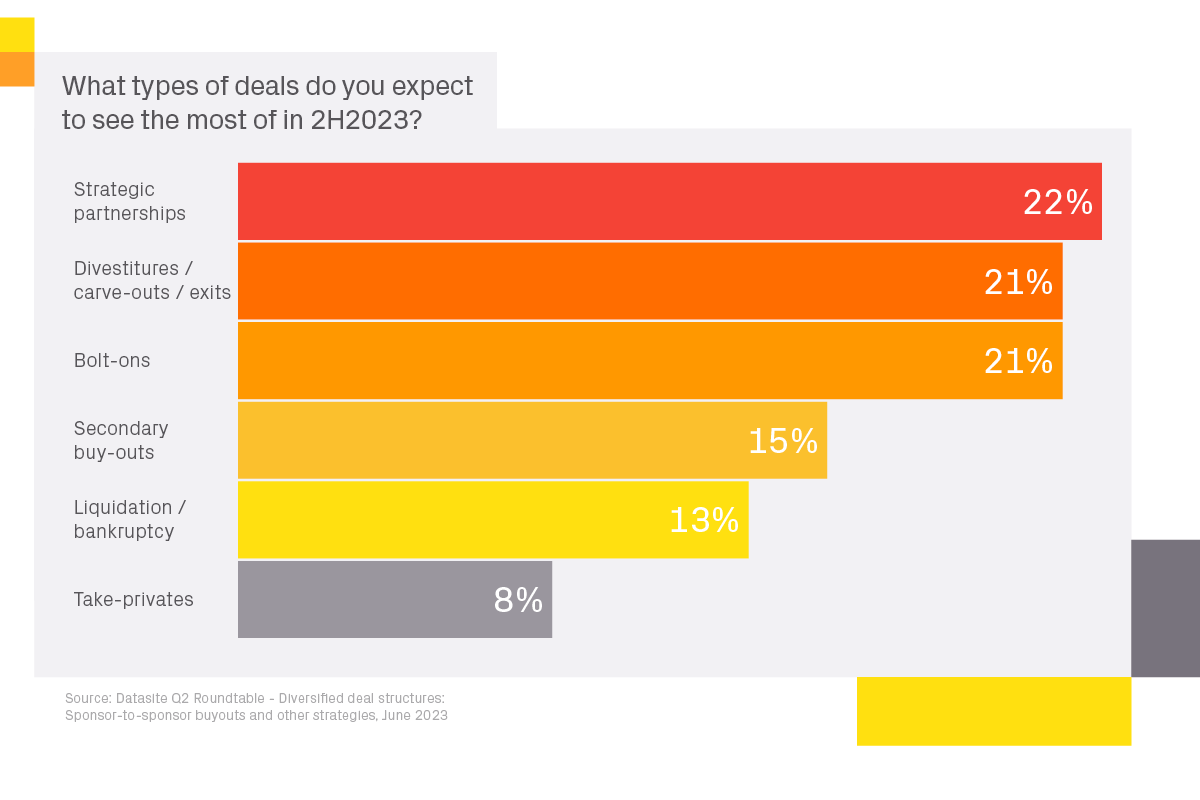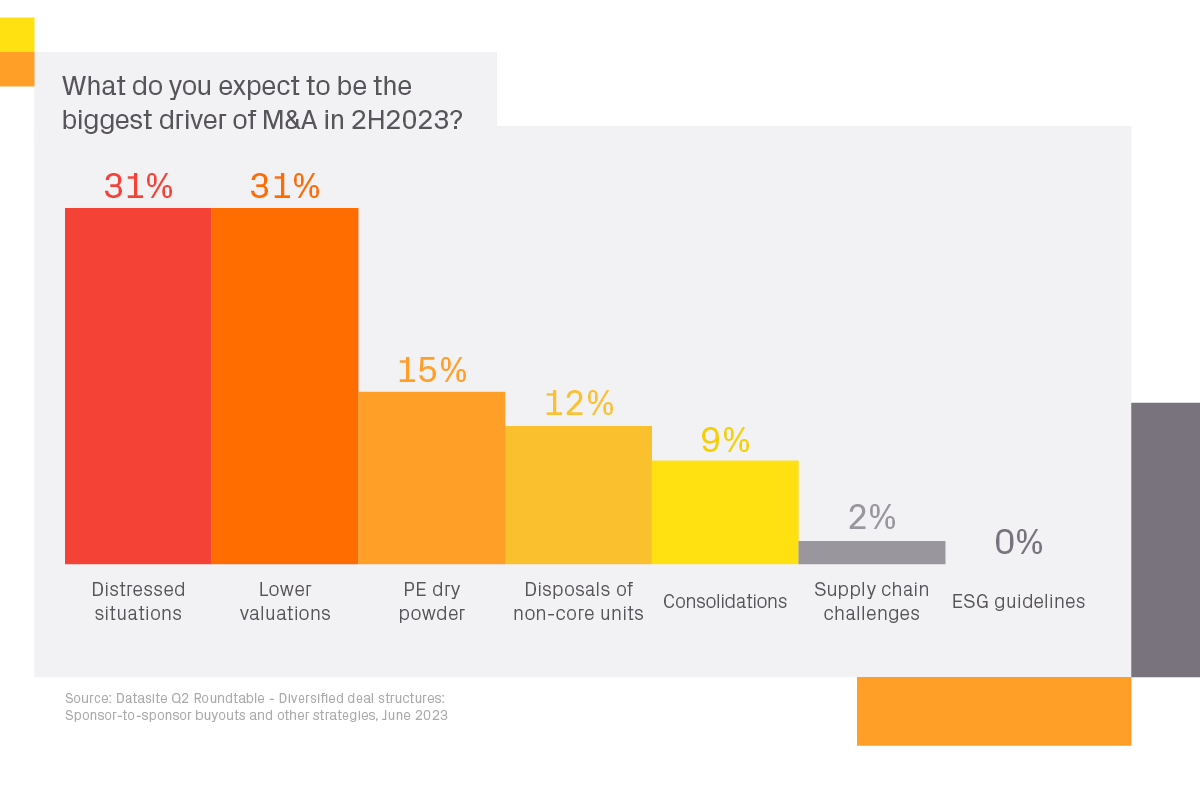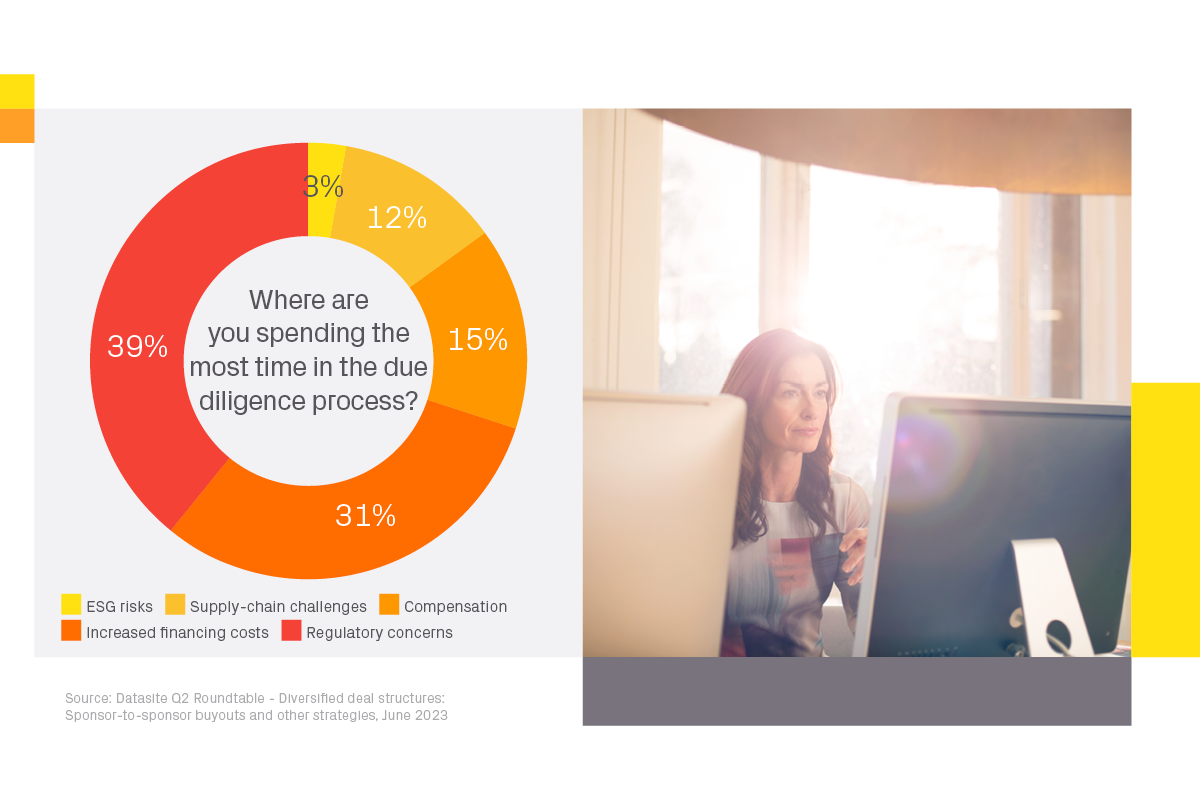
Insights
The New Architecture of M&A: Creative Deal Structures for Risk Management
June 26, 2023 | Blog
The New Architecture of M&A: Creative Deal Structures for Risk Management
Many dealmakers are looking to less-common transaction structures as they try to navigate the choppy waters of 2023. To examine this trend and what it might mean for the future of M&A, Datasite gathered expert voices from across the industry for a lively roundtable discussion.
Diverse Transaction Types on the Horizon
When asked what types of deals they expect to predominate in the second half of 2023, the panelists had a variety of answers. Both Carrie DiLauro, Director of Operations for Hamilton Robinson Capital Partners and Alex Lykken, Senior Analyst at PitchBook said they anticipate a lot of bolt-on acquisitions as firms seek to add value for their portfolio companies without taking on as much debt.
Keith Crawford, Global Head of M&A for the financial services firm State Street, predicted an uptick in liquidation and bankruptcy acquisitions due to pressures like market turbulence, inflation, and earnings pressure from investors. And Anastasia Kaup, Managing Director at Fund Finance Partners, said that she expects to see more strategic partnerships due to the challenging fundraising environment.
“Some institutional investors are exercising more pull,” she said. “They’re saying ‘We’d rather be a bigger fish in a smaller pond’ (rather than one of many investors in a broadly commingled fund)... and asset managers are really responding to that.”
Predictions from the audience poll were similarly diverse. 23% of respondents agreed with Kaup about strategic partnerships, while both bolt-ons and divestitures received 21% of the vote, and secondary buyouts and liquidations also received a fair amount of attention. 
Growth Returning to the M&A Market
Moderator Will Glusman, Senior Director of Product Marketing at Datasite, noted that signs of life are returning to the dealmaking world after the downturn of 2022. What’s driving this thaw?
One candidate may be the combination of dry powder and anticipation in the private markets. Buyers have been highly selective over the past few quarters due to macro-level headwinds, but they haven’t stopped searching. Kaup noted that many of her clients were waiting in the wings for the chance to best take advantage of the disrupted market.
The recent shocks to the tech world may also represent a significant opportunity for buyers.
“Tech founders — many of whom were riding high just a couple of years ago — could be persuaded to sell for the right price, even if it’s lower than what they wanted,” Lykken said.
Though we may see fewer headline-grabbing mega-deals, he expects significant activity in this space.
DiLauro nominated the industrial sector as another promising target. Given recent leaps forward in technology and automation, and the trend toward reshoring, her firm sees the advanced manufacturing. Kaup noted that she’d seen similar growth and increased interest from private equity sponsors investing in healthcare and life sciences.
Dealmaking Continues to Evolve
With many buyers still seeing a disconnect between the market’s expected performance and the valuations they’re being asked to pay, mitigating risk is a top priority. Glusman asked the group how this is affecting the way deals are structured.
DiLauro said that the private equity world is increasingly turning to earn-outs to bridge the valuation gap. Crawford seconded that and pointed to techniques like purchase price clawbacks and escrow holdings to reduce buy-side risk.
Kaup, whose firm deals specifically with debt-financed deals, added that it’s often possible to secure better terms when leveraging an entire portfolio of investments, or obtaining financing at the fund level, rather than leveraging one asset at a time or obtaining financing at the asset level.
Lykken said he’s seeing more secondary, tertiary, and even quaternary private buyouts, citing recent findings from a joint study by Datasite and PitchBook. As PE firms become increasingly specialized in terms of asset size and industry, their expertise often allows them to realize more value from sponsor-to-sponsor buyouts. For private buyers, adopting a laser focus on the types of targets they know best could be another way to reduce the risk of winding up with underperforming assets.
Could More Diligence Mean More Deals Completed?
Due diligence times also seem to be on the rise. And contrary to the prevailing wisdom, Datasite’s research suggests that more time spent in this phase is associated with better rates of deal closing. Glusman asked the panelists if they’ve been noticing an increase in caution during diligence — and if so, what’s behind it.
There was broad agreement that diligence times are rising. Crawford said that in his industry, the increase is often driven by the need for Reps and Warranties insurance and associated underwriting. He also said that a more cumbersome regulatory environment has extended the timeline. The audience members agreed, with 38% saying that regulatory concerns consumed the biggest chunk of due diligence time.
DiLauro said that in her experience, the increase in diligence is largely driven by an ongoing mismatch in valuations. Buyers are being asked to commit to purchase prices based on peak earnings, even though the economy remains unstable.
“In these uncertain times, a PE shop is diligencing everything they can to de-risk,” she said. Kaup agreed, saying extended diligence is often related to increased caution on the parts of asset managers and private equity sponsors, and their lenders.
The panelists offered a few strategies for handling this increased diligence load. Kaup, given her focus on debt and leverage, advised dealmakers to be selective when picking lending partners, and to work with knowledgeable and experienced advisors when seeking and installing debt financing.
“Someone who’s going to be doing a market-appropriate level of due diligence, who’s focused on the same things, who understands your priorities as a sponsor — that’s all very critical,” she said.
Crawford mentioned that he’s found clean team agreements very helpful for enabling access to data that otherwise might not be available until just before closing. This can be a valuable way to make sure you have a realistic understanding of the risk you’re taking on.
Opportunities Remain for Savvy Dealmakers
Despite the headwinds of inflation and costly credit, there’s still room for successful plays if dealmakers are willing to look beyond traditional M&A structures. Careful prep work can help you limit your risk and come out of the current turbulence on top.


